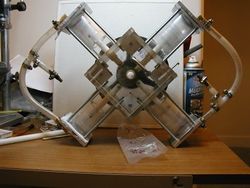Stirling Engine: Difference between revisions
Jump to navigation
Jump to search


No edit summary |
No edit summary |
||
| Line 2: | Line 2: | ||
[[File:OldOlympus_299.jpg|250px|thumb|right|'''Current version of the prototype'''. Assembled version with piston rod guides. See [http://openstirlingengine.blogspot.com/ blog] for detailed status reports. Having problems with polyethylene bags developing leaks, so not running yet. ]] | [[File:OldOlympus_299.jpg|250px|thumb|right|'''Current version of the prototype'''. Assembled version with piston rod guides. See [http://openstirlingengine.blogspot.com/ blog] for detailed status reports. Having problems with polyethylene bags developing leaks, so not running yet. ]] | ||
=Overview= | =Overview= | ||
A Stirling | A [[Stirling Engine]] can operate quietly from any heat source to generate mechanical power (work). It operates by operates by cyclic compression and expansion of air or other gas, the working fluid, at different temperature levels such that there is a net conversion of heat energy to mechanical work. It can be coupled directly to a hydraulic transmission, although only a handful of projects have explored this possibility over the decades. | ||
Heat sources include [[Solar Concentration]] power as well as [[biomass]]. | |||
==Applications and Product Ecology== | |||
* In future versions of the [[GVCS]], such a concept may be used for the [[Power Cube]] | |||
* can be coupled to water pumps for irrigation | |||
* biomass: heat can be derived from combustion or from [[pyrolysis]], where [[biochar]] would be a useful, carbon-negative byproduct. With biomass-powered Stirling engine, one single engine could handle all sorts of different biomass, whether solid, liquid or gaseous. There is no need for tedious clean-up of fuel. | |||
* liquid piston Stirling engine | |||
''' | ==Projects== | ||
'''Open Source Stirling Engines''' | |||
*[http://sites.google.com/site/openstirlingengine/Home Open Stirling Engine] | *[http://sites.google.com/site/openstirlingengine/Home Open Stirling Engine] | ||
*[http://www.pureenergysystems.com/os/StirlingEngine/ Stirling Engine Open Sourcing Projects] | *[http://www.pureenergysystems.com/os/StirlingEngine/ Stirling Engine Open Sourcing Projects] | ||
| Line 14: | Line 22: | ||
*[http://www.whispergen.com/content/library/Don_Clucas_Stirling_engine_generator_development.pdf Stirling Engine Generator Development] | *[http://www.whispergen.com/content/library/Don_Clucas_Stirling_engine_generator_development.pdf Stirling Engine Generator Development] | ||
*[http://www.cd3wd.com/cd3wd_40/VITA/STIRLING/EN/STIRLING.HTM Understanding Sterling Engines] | *[http://www.cd3wd.com/cd3wd_40/VITA/STIRLING/EN/STIRLING.HTM Understanding Sterling Engines] | ||
==See Also== | |||
*[http://en.wikipedia.org/wiki/Stirling_engine Wikipedia: Stirling Engine] | |||
*[http://peswiki.com/index.php/Directory:Deluge_Inc:Thermal_Hydraulic_Engine Deluge Thermal Hydraulic Engine] | *[http://peswiki.com/index.php/Directory:Deluge_Inc:Thermal_Hydraulic_Engine Deluge Thermal Hydraulic Engine] | ||
*[[Media:NASA Stirling Hydraulic concept.pdf|NASA 1988 Project]]. | |||
*[http://www.google.com/patents/about?id=mdJ-AAAAEBAJ&dq=Stirling+engine+with+hydraulic+output Patent (2007): Stirling engine with hydraulic output] | |||
*[http://linkinghub.elsevier.com/retrieve/pii/S0960148109000494 Mobile hydraulic power supply] | |||
*[[Wikipedia: Fluidyne engine]] | |||
[[Category:Energy]] | [[Category:Energy]] | ||
[[Category:Solar Power | [[Category:Solar Power]] | ||
Revision as of 05:56, 5 September 2011

Alpha prototype under construction. See Open Stirling Engine blog for the current status of the first prototype of the 4 cylinder alpha configuration engine. This is a simplified version of the design as modeled in Google SketchUp

Current version of the prototype. Assembled version with piston rod guides. See blog for detailed status reports. Having problems with polyethylene bags developing leaks, so not running yet.
Overview
A Stirling Engine can operate quietly from any heat source to generate mechanical power (work). It operates by operates by cyclic compression and expansion of air or other gas, the working fluid, at different temperature levels such that there is a net conversion of heat energy to mechanical work. It can be coupled directly to a hydraulic transmission, although only a handful of projects have explored this possibility over the decades.
Heat sources include Solar Concentration power as well as biomass.
Applications and Product Ecology
- In future versions of the GVCS, such a concept may be used for the Power Cube
- can be coupled to water pumps for irrigation
- biomass: heat can be derived from combustion or from pyrolysis, where biochar would be a useful, carbon-negative byproduct. With biomass-powered Stirling engine, one single engine could handle all sorts of different biomass, whether solid, liquid or gaseous. There is no need for tedious clean-up of fuel.
- liquid piston Stirling engine
Projects
Open Source Stirling Engines
- Open Stirling Engine
- Stirling Engine Open Sourcing Projects
- Energy and Sterling Engines
- Stirling Engine Generator Development
- Understanding Sterling Engines